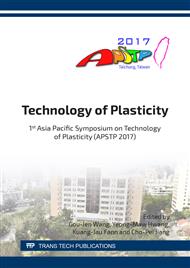p.16
p.22
p.28
p.34
p.40
p.46
p.52
p.58
p.64
Process Analysis of Fabricating Elbow Tubes by Mandrel Bending Process
Abstract:
The process of tube bending involves using mechanical force to push stock material pipe or tubing against a die, forcing the pipe or tube to conform to the shape of the die. For some tube bending processing, a mandrel is placed inside the tube to prevent collapsing. In this study, the elbow bending process using mandrel has been investigated to fabricate precise elbow-shaped tubes. To fabricate tube having target shape within the dimensional tolerance, the process analysis has been performed at various processing parameters such as tube dimensions, tilting angles, curved cutting surface and the radius of curvature. To estimate the dimensional accuracies of formed tubes, the standard deviations of dimensional errors between target and formed tubes have been used as a quantitative index. Results show that the elbow tube having larger radius of curvature shows higher dimensional accuracy due to the relatively uniform strain distribution. And the convex cutting surface is desirable to increase contacts between the punch and the tube ends during the bending process.
Info:
Periodical:
Pages:
40-45
Citation:
Online since:
April 2018
Authors:
Keywords:
Price:
Сopyright:
© 2018 Trans Tech Publications Ltd. All Rights Reserved
Share:
Citation:


